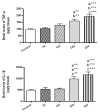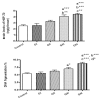Zinc Oxide Nanoparticles Induced Oxidative DNA Damage, Inflammation and Apoptosis in Rat's Brain after Oral Exposure
- PMID: 29861430
- PMCID: PMC6027438
- DOI: 10.3390/toxics6020029
Zinc Oxide Nanoparticles Induced Oxidative DNA Damage, Inflammation and Apoptosis in Rat's Brain after Oral Exposure
Abstract
Growing evidences demonstrated that zinc oxide nanoparticles (ZnONPs) could reach the brain after oral ingestion; however, the "neurotoxicity of" ZnONPs after oral exposure has not been fully investigated. This study aimed to explore the "neurotoxicity of" ZnONPs (.
Keywords: DNA fragmentation; Fas; ZnONPs; brain; caspase-3; heat shock protein-70; interleukin-1β; oxidative stress.
Conflict of interest statement
The authors declare they have no competing interests.
Figures






References
-
- Silva G.A. Neuroscience nanotechnology: Progress, opportunities and challenges. [(accessed on 3 May 2017)];Nat. Rev. Neurosci. 2006 7:65–74. doi: 10.1038/nrn1827. Available online: https://www.ncbi.nlm.nih.gov/pubmed/16371951. - DOI - PubMed
-
- De Matteis V., Rinaldi R. Toxicity Assessment in the Nanoparticle Era. [(accessed on 6 May 2018)];Adv. Exp. Med. Biol. 2018 1048:1–19. doi: 10.1007/978-3-319-72041-8_1. Available online: https://www.ncbi.nlm.nih.gov/pubmed/29453529. - DOI - PubMed
-
- Vandebriel R.J., De Jong W.H. A review of mammalian toxicity of ZnO nanoparticles. [(accessed on 11 November 2017)];Nanotechnol. Sci. Appl. 2012 5:61–71. doi: 10.2147/NSA.S23932. Available online: https://www.ncbi.nlm.nih.gov/pmc/articles/PMC3781722/ - DOI - PMC - PubMed
-
- Yah C.S., Simate G.S., Iyuke S.E. Nanoparticles toxicity and their routes of exposures. [(accessed on 3 December 2017)];Pak. J. Pharm. Sci. 2012 25:477–491. doi: 10.5772/51230. Available online: https://www.intechopen.com/books/recent-advances-in-novel-drug-carrier-s.... - DOI - PubMed
-
- Singh S., Nalwa H.S. Nanotechnology and health safety-toxicity and risk assessments of nanostructured materials on human health. [(accessed on 19 November 2017)];J. Nanosci. Nanotechnol. 2007 7:3048–3070. doi: 10.1166/jnn.2007.922. Available online: https://www.ncbi.nlm.nih.gov/pubmed/18019130. - DOI - PubMed
LinkOut - more resources
Full Text Sources
Other Literature Sources
Research Materials
Miscellaneous

